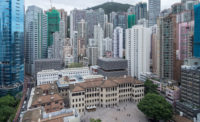Seattle
Although just 1,800 Amtrak passengers use it each day, the recently renovated King Street Station in Seattle serves as a landmark and urban catalyst at the junction of several changing neighborhoods. With historic Pioneer Square to the north and the ethnically diverse International District to the east, the station is playing an important role in stitching together a part of town that had become quite ragged over the past few decades. Major new developments nearby— such as two sports stadiums and a $300 million mixed-use complex called Stadium Place—are turning the area into a critical hub increasingly reliant on mass transportation. Within just a few blocks, you'll find a Sounder commuter rail station, two Link light-rail stations connecting downtown to the Seattle-Tacoma airport, and, starting this fall, new streetcar stops.
The station's fortunes changed for the better when the City of Seattle bought the building in 2008 for $10 from the Burlington Northern Santa Fe Railroad and, in 2010, hired ZGF Architects to oversee a complete renovation. The city's department of transportation would eventually cobble together $55 million in funding from 15 different sources, including federal, state, and city agencies, and nonprofit organizations. By restoring the 62,400-square-foot building to its former glory, government officials hoped to use the project as leverage to revive Seattle's original downtown, an area dating back to 1852. All the work on the station had to be done while Amtrak used the facility without interruption.
Even before ZGF got involved, the city started repairing the old building. In 2008, it hired Otak—a planning, design, and engineering firm—to renovate the station's roofs, specifying new green-glazed terra-cotta tiles from the company that manufactured the original ones and installing them on the main building. On the campanile, it used salvaged glass tiles for the pyramidal roof and fixed the four clocks.
Once ZGF was onboard, work began on a major seismic upgrading that would eventually account for more than 40 percent of the project's total cost, $55 million. In the main public areas, ZGF and engineers at Arup carefully slipped new steel elements behind surfaces whose historic finishes were being restored. To keep the new structure flush with the building envelope, the designers cut 35-foot-high slots within the brick perimeter, inserted steel columns and high-strength grouting, then connected the columns with flat steel plates. In places where historic finishes were not being restored, they employed less expensive steel cross bracing.
For most people catching trains at the station today, the big wow happens in the main waiting room, where a suspended ceiling installed in the 1960s was removed to reveal the original ornate one and to bring in more daylight from clerestory windows. Repairing the old ceiling and other plasterwork involved creating molds from existing sections and then casting new sections using traditional materials such as plaster, hemp, and burlap. The architects also brought lush materials back to other surfaces, finishing walls with gray-veined white marble from Carrara, Italy (since the original quarries in Alaska had closed) and repairing terrazzo floors and jewel-toned mosaic tiles on both walls and floors.
On the exterior, ZGF simplified vehicular and pedestrian traffic on the King Street side, while rebuilding the metal canopy over the entrance. The firm removed the 1960s escalator that had marred this elevation and rebuilt a covered staircase that connects the King Street entrance to Jackson Street 18 feet above. Eliminating a parking lot on Jackson Street, the architects redesigned this upper level as a pedestrian plaza with planters and seating, and recreated 23 old bronze-and-glass light stanchions now equipped with LEDs.
From the beginning of the project, the client made sustainability a critical goal. As a result, the building today consumes 68 percent less energy than before the renovation, according to ZGF. To accomplish this, the firm dug geothermal wells below the Jackson Street plaza, used ground-source heat pumps for heating and cooling, and restored operable windows throughout the building. Photovoltaics on a restored trackside canopy and water harvesting for toilet flushing also helped the project earn LEED Platinum certification.
“King Street Station had long played a critical role in the civic life of the city,” says Tim Williams, the project manager at ZGF. “Our goal was to restore that.” The building's ties to the rest of the city will be strengthened when retail space adjacent to the Jackson Street plaza is leased and more direct connections are made to the commuter and Link rail stations. Until then, the building bridges Seattle's past to a still-evolving future.
People
Client:
Owner:
Architect:
Personnel in architect's firm who should receive special credit: Interior designer: ZGF Architects LLP
Engineers:
Consultant(s): Lighting: Pivotal Lighting Design | Affiliated Engineers, Inc. | Eleek Inc. Acoustical: Sparling
Historical Preservation Consultant: Artifacts Consulting, Inc. General Contractor: Sellen Construction
Photographer(s):
Doug Scott Size: 62,400 square feet Construction cost: $39 million Project cost: $55 million Completion date: May 2013 |
Products
Structural system
Exterior cladding
Windows
Glazing Skylights: Evergreen House
Doors Metal doors: American Direct Wood doors: American Direct Fire-control doors, security grilles: Cornell
Hardware Closers: Norton Exit devices: Record Pulls: Trimco Security devices: ACSI Other special hardware: Brass Cladding: Tice
Interior finishes Floor and wall tile: Mixed-up Mosaics – column capitals
Special interior finishes unique to this project: Interior marble – Architectural Stone and Tile / Synergism
Furnishings
Lighting Exterior: Sistemalux Dimming System or other lighting controls: Cooper Lighting Control
Conveyance
Plumbing
Energy Photovoltaic system: Sharp |










Post a comment to this article
Report Abusive Comment